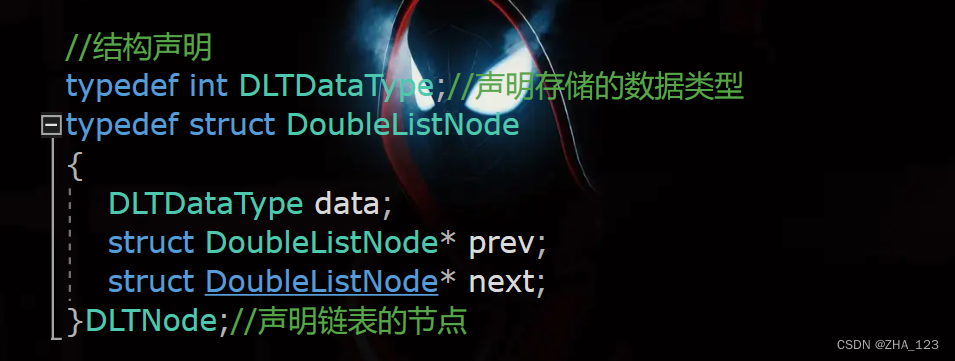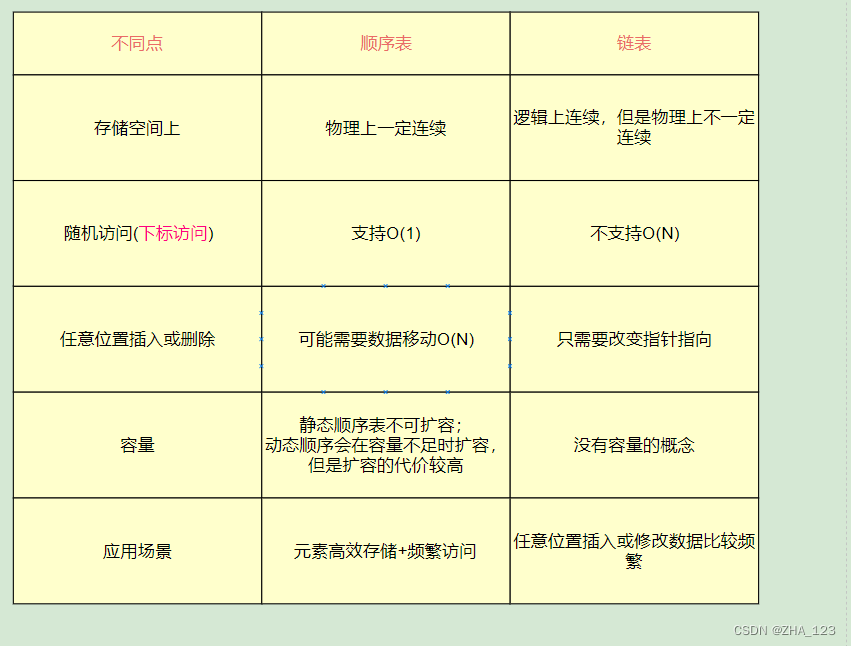链表
一. 链表的介绍
1.1 链表的概念及结构
概念:链表是一种物理存储结构上非连续、非顺序的存储结构,数据元素的逻辑顺序是通过链表
中的指针链接次序实现的 。

注意三点:
- 由图可以看出链表的结构在逻辑上是连续的,但是在内存中不一定连续。
- 链表的结点是在堆上开辟的。
- 在堆上开辟的两段空间,可能连续,也可能不连续。
1.2 链表的分类
单向与双向
单向链表

双向链表

带头与不带头
带头

不带头

循环与不循环
循环

不循环

将这三类排列组合可以形成8种链表
我们主要讲解两类
1.单向不带头不循环链表
2.双向带头循环链表
二. 单向不带头不循环链表

无头单向非循环链表:结构简单,一般不会单独用来存数据。实际中更多是作为其他数据结
构的子结构,如哈希桶、图的邻接表等等。另外这种结构在笔试面试中出现很多。
2.1 单链表的实现代码
大概的结构可以用以下代码展示:

data代表的是每一个节点存储的数据,next代表的是指向下一个结点的指针,如果没有下一个结点,那么next就为空。
2.1.1 头文件——SList.h
#pragma once
#include <stdio.h>
#include <stdlib.h>
#include <assert.h>
typedef int SLTDateType;
typedef struct SListNode
{
SLTDateType data;
struct SListNode* next;
}SListNode;
// 动态申请一个节点
SListNode* BuySListNode(SLTDateType x);
//创建一个有n个节点的单链表
SListNode* CreatSListNode(int n);
// 单链表打印
void SListPrint(SListNode* plist);
// 单链表尾插
void SListPushBack(SListNode** pplist, SLTDateType x);
// 单链表的头插
void SListPushFront(SListNode** pplist, SLTDateType x);
// 单链表的尾删
void SListPopBack(SListNode** pplist);
// 单链表头删
void SListPopFront(SListNode** pplist);
// 单链表查找
SListNode* SListFind(SListNode* plist, SLTDateType x);
// 单链表在pos位置之后插入x
void SListInsertAfter(SListNode* pos, SLTDateType x);
// 单链表在pos位置之前插入x
void SListInsertBefore(SListNode** plist, SListNode* pos, SLTDateType x);
// 单链表删除pos之后位置
void SListEraseAfter(SListNode* pos);
//单链表删除pos位置
void SListErase(SListNode** pplist, SListNode* pos);
// 单链表的销毁
void SListDestroy(SListNode** plist);
2.1.2 具体函数实现文件——SList.c
#define _CRT_SECURE_NO_WARNINGS 1
#include "SList.h"
// 动态申请一个节点
SListNode* BuySListNode(SLTDateType x)
{
SListNode* phead = (SListNode*)malloc(sizeof(SListNode));
if (phead == NULL)
{
perror("malloc failed");
exit(-1);
}
else
{
phead->data = x;
phead->next = NULL;
}
return phead;
}
//创建一个有n个节点的单链表
SListNode* CreatSListNode(int n)
{
SListNode* phead = NULL, * ptail = NULL;
for (int i = 0; i < n; i++)
{
SListNode* NewNode = BuySListNode(i);
if (phead == NULL)
{
ptail = phead = NewNode;
}
else
{
ptail->next = NewNode;
ptail = NewNode;
}
}
return phead;
}
// 单链表打印
void SListPrint(SListNode* plist)
{
SListNode* cur = plist;
while (cur)
{
printf("%d->", cur->data);
cur = cur->next;
}
printf("NULL\n");
}
// 单链表尾插
void SListPushBack(SListNode** pplist, SLTDateType x)
{
SListNode* NewNode = BuySListNode(x);
//链表为空时也可以尾插
if (*pplist == NULL)
{
*pplist = NewNode;
}
else
{
SListNode* tail = *pplist;
while (tail->next)
{
tail = tail->next;
}
tail->next = NewNode;
}
}
// 单链表的头插
void SListPushFront(SListNode** pplist, SLTDateType x)
{
SListNode* NewNode = BuySListNode(x);
NewNode->next = *pplist;
*pplist = NewNode;
}
// 单链表的尾删
void SListPopBack(SListNode** pplist)
{
//链表为空就删不了了
assert(*pplist);
SListNode* tail = *pplist;
//一上来就已经是尾
if (tail->next == NULL)
{
free(tail);
*pplist = NULL;
}
else
{
方法1
//while (tail->next->next)
//{
// tail = tail->next;
//}
//free(tail->next);
//tail->next = NULL;
//方法2
SListNode* pre = NULL;
while (tail->next)
{
pre = tail;
tail = tail->next;
}
free(tail);
pre->next = NULL;
}
}
// 单链表头删
void SListPopFront(SListNode** pplist)
{
assert(*pplist);
SListNode* tmp = (*pplist)->next;
free(*pplist);
*pplist = tmp;
}
// 单链表查找
SListNode* SListFind(SListNode* plist, SLTDateType x)
{
SListNode* cur = plist;
while (cur)
{
if (cur->data == x)
{
return cur;
}
else
{
cur = cur->next;
}
}
}
// 单链表在pos位置之后插入x
void SListInsertAfter(SListNode* pos, SLTDateType x)
{
if (pos == NULL)
{
return;
}
else
{
SListNode* newnode = BuySListNode(x);
newnode->next = pos->next;
pos->next = newnode;
}
}
// 单链表在pos位置之前插入x
void SListInsertBefore(SListNode** pplist, SListNode* pos, SLTDateType x)
{
if (*pplist == pos)
{
SListPushFront(pplist, x);
}
else
{
SListNode* newnode = BuySListNode(x);
SListNode* pre = *pplist;
while (pre->next != pos)
{
pre = pre->next;
}
newnode->next = pre->next;
pre->next = newnode;
}
}
// 单链表删除pos之后位置
void SListEraseAfter(SListNode* pos)
{
assert(pos);
if (pos->next == NULL)
{
return;
}
else
{
SListNode* tmp = pos->next;
pos->next = pos->next->next;
free(tmp);
}
}
// 单链表删除pos当前位置
void SListErase(SListNode** pplist, SListNode* pos)
{
assert(pos && *pplist);
if (*pplist == pos)
{
SListPopFront(pplist);
}
else
{
SListNode* cur = *pplist;
while (cur->next != pos)
{
cur = cur->next;
}
cur->next = pos->next;
free(pos);
}
}
// 单链表的销毁
void SListDestroy(SListNode** pplist)
{
SListNode* pre = *pplist;
SListNode* cur = *pplist;
while (cur->next)
{
pre = cur->next;
free(cur);
cur = pre;
}
*pplist = NULL;
}
关于程序的测试,大家可以自己写一个主函数进行测试。
三. 双向带头循环链表

带头双向循环链表:结构最复杂,一般用在单独存储数据。实际中使用的链表数据结构,都
是带头双向循环链表。另外这个结构虽然结构复杂,但是使用代码实现以后会发现结构会带
来很多优势,实现反而简单了,后面我们代码实现了就知道了。
3.1 双向带头循环链表的实现代码
结构声明的代码:

双向带头循环链表的结构相对复杂,但是各个功能的实现其实是很简单的。接下来请看代码
3.1.1 头文件——DList.h
#pragma once
//头文件包含
#include <stdio.h>
#include <stdlib.h>
#include <assert.h>
#include <stdbool.h>
//结构声明
typedef int DLTDataType;//声明存储的数据类型
typedef struct DoubleListNode
{
DLTDataType data;
struct DoubleListNode* prev;
struct DoubleListNode* next;
}DLTNode;//声明链表的节点
//函数声明
//创建新节点
DLTNode* BuyNode(DLTDataType x);
//初始化链表
DLTNode* DLTInit();
//打印链表
void DLTPrint(DLTNode* phead);
//链表头插
void DLTPushFront(DLTNode* phead, DLTDataType x);
//链表头删
void DLTPopFront(DLTNode* phead);
//链表尾插
void DLTPushBack(DLTNode* phead, DLTDataType x);
//链表尾删
void DLTPopBack(DLTNode* phead);
//链表查找
DLTNode* DLTFind(DLTNode* phead, DLTDataType x);
//在链表的pos节点前插入数据
void DLTInsertBefore(DLTNode* phead, DLTNode* pos, DLTDataType x);
//删除链表中pos节点的数据
void DLTErase(DLTNode* phead, DLTNode* pos);
3.1.2 具体函数实现——DList.c
#define _CRT_SECURE_NO_WARNINGS 1
#include "DList.h"
//创建新节点
DLTNode* BuyNode(DLTDataType x)
{
DLTNode* newNode = (DLTNode*)malloc(sizeof(DLTNode));
if (newNode == NULL)
{
perror("malloc failed");
exit(-1);
}
newNode->data = x;
newNode->next = NULL;
newNode->prev = NULL;
return newNode;
}
//初始化链表
DLTNode* DLTInit()
{
DLTNode* phead = BuyNode(-1);
phead->next = phead;
phead->prev = phead;
return phead;
}
//打印链表
void DLTPrint(DLTNode* phead)
{
assert(phead);
DLTNode* cur = phead->next;
while (cur != phead)
{
printf("%d ", cur->data);
cur = cur->next;
}
printf("\n");
}
//链表头插
void DLTPushFront(DLTNode* phead, DLTDataType x)
{
assert(phead);
//开辟新节点
DLTNode* newNode = BuyNode(x);
//保存原本的第一个节点
DLTNode* tmp = phead->next;
//更新链表
phead->next = newNode;
newNode->prev = phead;
newNode->next = tmp;
tmp->prev = newNode;
}
//链表头删
void DLTPopFront(DLTNode* phead)
{
assert(phead);
assert(phead->next != phead);
//保存要删除的节点
DLTNode* tmp = phead->next;
//更新链表
phead->next = tmp->next;
tmp->next->prev = phead;
//删除保存的节点
free(tmp);
}
//链表尾插
void DLTPushBack(DLTNode* phead, DLTDataType x)
{
assert(phead);
//申请新节点
DLTNode* newNode = BuyNode(x);
//保存原本的尾节点
DLTNode* tmp = phead->prev;
//更新链表
tmp->next = newNode;
newNode->prev = tmp;
phead->prev = newNode;
newNode->next = phead;
}
//链表尾删
void DLTPopBack(DLTNode* phead)
{
assert(phead);
assert(phead->next != phead);
//保存尾结点
DLTNode* tmp = phead->prev;
//将尾结点的上一个节点更新为新的尾结点
tmp->prev->next = phead;
phead->prev = tmp->prev;
//释放原本的尾结点
free(tmp);
}
//链表查找
DLTNode* DLTFind(DLTNode* phead, DLTDataType x)
{
assert(phead);
DLTNode* cur = phead->next;
while (cur != phead)
{
if (cur->data == x)
{
return cur;
}
cur = cur->next;
}
return NULL;
}
//在链表的pos节点前插入数据
void DLTInsertBefore(DLTNode* phead, DLTNode* pos, DLTDataType x)
{
assert(phead);
assert(pos);
//申请一个新节点
DLTNode* newNode = BuyNode(x);
//更新链表
pos->prev->next = newNode;
newNode->prev = pos->prev;
newNode->next = pos;
pos->prev = newNode;
}
//删除链表中pos节点的数据
void DLTErase(DLTNode* phead, DLTNode* pos)
{
assert(phead);
assert(pos);
assert(phead->next != phead);
DLTNode* tmp = pos->next;
pos->prev->next = tmp;
tmp->prev = pos->prev;
free(pos);
}
四. 顺序表与链表的对比

五. 总结
其实主要的思想还是提现在代码上,感谢大家耐心看完。之后的一篇博客会讲一下关于链表的OJ题。
